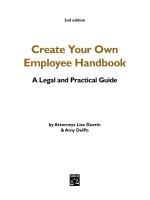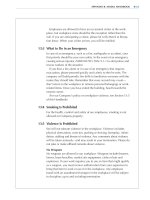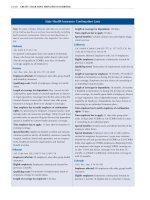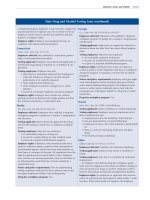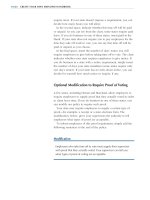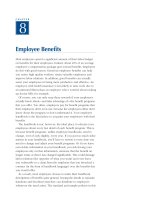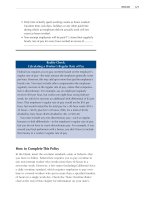create your own employee handbook a legal and practical guide phần 6 doc
Bạn đang xem bản rút gọn của tài liệu. Xem và tải ngay bản đầy đủ của tài liệu tại đây (369.17 KB, 44 trang )
WORKPLACE BEHAVIOR 12/13
12:6 Horseplay
Horseplay is boisterous physical interaction that disrupts the ordinary
operation of a workplace. It usually begins innocently enough,
arising from the more juvenile and playful impulses of your
employees. Initially, it does not involve malice, ill will or anger—
it’s just a matter of employees goofing off.
That being said, such aggressive playful conduct can often get
out of hand, and what started out as innocent, yet loud, fun can
turn into a fight or a brawl. Depending on the circumstances, it can
also turn into discrimination, harassment or assault. It is also a
safety hazard.
Because horseplay is disruptive and can often lead to trouble,
many employers ban it outright.
Standard Policy
Horseplay
Although we want our employees to have fun while they work, we
don’t allow employees to engage in horseplay—which is fun that
has gotten loud and boisterous and out of control. Horseplay
disrupts the work environment and can get out of hand, leading to
fighting, hurt feelings, safety hazards or worse.
Employees who engage in horseplay will face disciplinary action,
up to and including termination.
12/14 CREATE YOUR OWN EMPLOYEE HANDBOOK
12:7 Fighting
Fights among employees not only injure the people involved, they
damage collegiality among workers, disrupt the workplace and,
sometimes, lead to more violence, physical and emotional injuries
and lawsuits. This policy prohibits fighting among employees and
promises disciplinary action to those who engage in it. Verbal
fighting can be just as damaging as physical fighting and is there-
fore encompassed by this policy.
Standard Policy
Fighting
Verbal or physical fighting among employees is absolutely prohibited.
Employees shall not engage in, provoke or encourage a fight. Those
who violate this policy will be disciplined, up to and including
termination.
WORKPLACE BEHAVIOR 12/15
12:8 Sleeping on the Job
Depending on the type of business you run, employees who sleep
on the job can create anything from a nuisance to a safety hazard.
Most employers ban sleeping on the worksite outright, but some
employers who schedule employees for exceptionally long shifts
(for example, 24 hours) will expressly allow employees to sleep
during designated times.
The following standard policy prohibits sleeping entirely and is
designed for a business in which sleeping employees do not pose
a safety hazard. If you would like to allow employees to sleep at
designated times, or if you would like to emphasize the unsafe
nature of sleeping, see the modifications that follow the standard
policy.
Standard Policy
Sleeping on the Job
When our employees arrive at work, we expect them to be physi-
cally prepared to work through their day. Employees who sleep on
the job dampen morale and productivity and deprive us of their
work and companionship.
As a result, we do not allow any employees to sleep while at
work. Employees who feel sick or unable to finish the day because
of weariness should talk to
about using sick leave to take the rest of the day off. (See Section
of this Handbook for information about our sick leave policy.)
Optional Modifications
To Allow Employees to Sleep Sometimes
If you would like to allow your employees to sleep at certain
times, add the following to the bottom of the sample policy, above:
Modification
We make an exception to this policy for certain employees who
. To find out if you fit
within this exception, contact .
12/16 CREATE YOUR OWN EMPLOYEE HANDBOOK
To Emphasize the Safety Hazard of Sleeping
If employees who sleep on the job pose a safety risk (either to
themselves or to others), make the following paragraph the second
paragraph of the sample policy, above:
Modification
For certain employees, sleeping on the job creates a safety hazard.
Employees who work in [
describe—either by department or job
title—which employees pose a safety hazard when they sleep] create
unacceptable risks to their own safety and the safety of others when
they fail to be attentive and alert while working. For these employees,
sleeping on the job violates both this policy and our safety policies.
(See Section
of this Handbook for information about our safety
program.)
WORKPLACE BEHAVIOR 12/17
12:9 Insubordination
Employee insubordination comes in two forms: (1) refusing to
obey direct orders or instructions and (2) undermining authority
through words and conduct. Insubordination is a particularly
destructive force in the workplace, because it interferes with one of
your most basic rights as an employer: to operate your business as
you see fit. This means telling your employees what jobs need to
be done and how—and expecting them to obey. It also means
directing and controlling your company’s business and culture.
Of course, not every time an employee refuses to follow an order
is insubordination. Under federal law and the laws of most states,
employees have a right to refuse to work in unsafe conditions.
Similarly, they also have a right to refuse to do anything illegal.
And these legal issues aren’t the only reason to have an insubor-
dination policy with some flexibility in it: Sometimes, your employees
might have ideas about how jobs can be done better and more
efficiently. You don’t want to completely squelch employee opinion
and innovation by turning your workers into robots who unthink-
ingly follow your orders.
The following standard policy prohibits insubordination, but it
also explains to employees how to disobey orders in an acceptable
way if circumstances warrant.
12/18 CREATE YOUR OWN EMPLOYEE HANDBOOK
Standard Policy
Insubordination
This workplace operates on a system of mutual respect between
supervisors and employees. Supervisors must treat their employees
with dignity and understanding, and employees must show due
regard for their supervisors’ authority.
Insubordination occurs when employees unreasonably refuse to
obey the orders or follow the instructions of their supervisors. It also
occurs when employees, through their actions or words, show
disrespect toward their supervisors.
Insubordinate employees will face discipline, up to and including
termination.
We understand, however, that there will be times when employees
have valid reasons for refusing to do as their supervisor says. Perhaps
the employee fears for his safety or the safety of others, believes
that following instructions will violate the law or pose some other
problem for this Company. Or maybe the employee thinks that
there is a better way to accomplish a goal or perform a task. When
these issues arise, we do not ask that employees blindly follow
orders. Instead, we ask that employees explain the situation to their
supervisor. If, after hearing the employee’s side, the supervisor
continues to give the same order or rule, the employee must either
obey or use the complaint procedures described in Section
of
this Handbook.
WORKPLACE BEHAVIOR 12/19
12:10 Progressive Discipline
In a progressive discipline system, employers use a range of disci-
plinary actions and counseling sessions to motivate employees to
improve their conduct. In such a system, the goal of the discipline
is not punitive, but rather is communicative. A progressive discipline
system can be a valuable tool in improving employee performance
and productivity. It can also protect you from lawsuits by ensuring
that you are fair to employees and by forcing you to document
employee misconduct and your responses to it.
If you have a progressive discipline system at your workplace,
you should explain it to employees in general terms in your hand-
book.
Progressive discipline systems vary greatly from workplace to
workplace. As a result, we cannot provide standard policy language.
An example of what a progressive discipline policy might look like
the one on the next page.
Reality Check: Follow Your Disciplinary Policy
If you put a written progressive discipline policy in your handbook,
you must follow it—even when you don’t want to. From an employee
relations standpoint, your failure to follow your own policies will
only make you look arbitrary and unfair. In addition, you might
have trouble convincing employees to follow rules when you fail to
do so.
From a legal standpoint, failing to follow your own progressive
discipline policy leaves you vulnerable to lawsuits. Even if you
have a good reason for firing someone, you’ll have trouble proving
it if you didn’t follow your own policy. In addition, some courts
might view a written policy as a type of contract between you and
your employees. In such a situation, the court might view your
failure to follow the policy as a breach of contract.
To learn more about progressive
discipline, including how to
create such a system in your work-
place, see Dealing With Problem
Employees: A Legal Guide, by Amy
DelPo & Lisa Guerin (Nolo).
12/20 CREATE YOUR OWN EMPLOYEE HANDBOOK
SAMPLE POLICY LANGUAGE:
Any employee conduct that, in the opinion of the Company,
interferes with or adversely affects our business is sufficient
grounds for disciplinary action.
Disciplinary action can range from oral warnings to immediate
discharge. Our general policy is to take disciplinary steps in the
following order:
• oral warning(s)
• written reprimand(s)
• suspension, and
• termination.
However, we reserve the right to alter the order described
above, to skip disciplinary steps, to eliminate disciplinary steps or
to create new and/or additional disciplinary steps.
In choosing the appropriate disciplinary action, we may
consider any number of the following things:
• the seriousness of your conduct
• your history of misconduct
• your employment record
• your length of employment with this Company
• the strength of the evidence against you
• your ability to correct the conduct
• your attitude about the conduct
• actions we have taken for similar conduct by other
employees
• how your conduct affects this Company, its customers
and your coworkers, and
• any other circumstances related to the nature of the
misconduct, to your employment with this Company and
to the affect of the misconduct on the business of this
Company.
We will give those considerations whatever weight we deem
appropriate. Depending on the circumstances, we may give
some considerations more weight than other considerations—or
no weight at all.
Some conduct may result in immediate termination. Here are
some examples:
• theft of company property
• excessive tardiness or absenteeism
• arguing or fighting with customers, coworkers, managers
or supervisors
• brandishing a weapon at work
WORKPLACE BEHAVIOR 12/21
• threatening the physical safety of customers, coworkers,
managers or supervisors
• physically or verbally assaulting someone at work
• any illegal conduct at work
• using or possessing alcohol or illegal drugs at work
• working under the influence of alcohol or illegal drugs
• failing to carry out reasonable job assignments
• insubordination
• making false statements on a job application
• violating Company rules and regulations, and
• unlawful discrimination and harassment.
Of course, it is impossible to compile an exhaustive list of the
types of conduct that will result in immediate termination. The
ones listed above are merely illustrations.
You should remember that your employment is at the mutual
consent of you and this Company. This policy does not change
this fact. This means that you or this Company can terminate our
employment relationship at will, at any time, with or without
cause, and with or without advance notice.
As a result, this Company reserves its right to terminate your
employment at any time, for any lawful reason, including reasons
not listed above. You also have the right to end your employ-
ment at any time.
■
CHAPTER
13
Health and Safety
Workplace safety is of paramount concern to savvy employers—
and for good reason. Dangerous situations, accidents, violence or
breaches of security can have disastrous workplace consequences,
including lost productivity, raised insurance premiums, stolen or
damaged equipment, employee injuries or even deaths.
What’s more, the government regulates workplace safety issues
very heavily. Both federal and state laws require you to provide a
workplace free of hazards that could cause serious harm to your
employees. These laws also require you to investigate and report
workplace accidents, provide employees with safety training for
their jobs and keep records on workplace safety. Depending on
the type of business you run, virtually every aspect of your opera-
tions may be subject to detailed safety rules.
Although you can never guarantee that your workplace will be
accident-free, policies that promote workplace safety are a good
start. This chapter includes policies on:
13:1 Workplace Safety 13/2
13:2 Workplace Security 13/4
13:3 What to Do in an Emergency 13/7
13:4 Smoking 13/9
13:5 Violence 13/13
13/2 CREATE YOUR OWN EMPLOYEE HANDBOOK
13:1 Workplace Safety
A basic safety policy is a must for every employer, no matter what
type of business you run. Federal and state laws require employers
to keep their workplace free of hazards, investigate accidents
quickly and keep proper safety records. You can’t meet these legal
requirements unless your employees follow safe work habits and
report workplace accidents and injuries—as our sample policy
directs them to do.
Your workplace safety policy should tell employees that safety is
a top concern for your company, let employees know about your
safety rules and explain how to report accidents or injuries.
Standard Policy
Safety Policy
Our Company takes employee safety very seriously. In order to
provide a safe workplace for everyone, every employee must follow
our safety rules:
•Horseplay, roughhousing and other physical acts that may
endanger employees or cause accidents are prohibited.
•Employees must follow their supervisors’ safety instructions.
•Employees in certain positions may be required to wear pro-
tective equipment, such as hair nets, hard hats, safety glasses,
work boots, ear plugs or masks. Your supervisor will let you
know if your position requires protective gear.
•Employees in certain positions may be prohibited from wear-
ing dangling jewelry or apparel, or may be required to pull
back or cover their hair, for safety purposes. Your supervisor
will tell you if you fall into one of these categories.
• All equipment and machinery must be used properly. This
means all guards, restraints and other safety devices must be
used at all times. Do not use equipment for other than its
intended purpose.
• All employees must immediately report any workplace
condition that they believe to be unsafe to their supervisor.
The Company will look into the matter promptly.
• All employees must immediately report any workplace
accident or injury to .
Some states require particular
policy language. The federal
law that regulates health and safety
on the job is called the Occupational
Safety and Health Act or OSHA (29
U.S.C. §§ 651 and following). In
addition, almost half the states have
adopted their own workplace safety
laws that are at least as strict as OSHA.
Although OSHA doesn’t require
employers to adopt a written work-
place safety policy, some of these
state laws do. For example, employers
in California must adopt a written
“injury and illness prevention pro-
gram.” To find out what your state
requires, contact your state labor
department (see Appendix C for
contact details)—or consult with an
experienced employment attorney.
HEALTH AND SAFETY 13/3
Optional Modification to Give Specific
Safety Instructions
Every type of industry has its own unique safety hazards. Our basic
standard policy can be modified to include safety rules particular to
yours. For example, you might want to include rules on the proper
use of certain types of equipment and machinery, proper techniques
for physical labor, such as lifting and carrying heavy objects, or
ergonomic rules for those who operate computers or cash registers
or perform other types of repetitive motions.
For more information on
federal and state health and
safety laws, go to the website of the
Occupational Safety and Health
Administration (OSHA), at www.
osha.gov. This federal agency admin-
isters workplace health and safety
rules. At its website, you can find a
number of helpful publications
describing your obligations as an
employer. You will also find a list of
parallel state agencies.
For policies on workplace
behavior, see Chapter 12.
13/4 CREATE YOUR OWN EMPLOYEE HANDBOOK
13:2 Workplace Security
A workplace security policy explains what measures you expect
your employees to take to keep your premises and property safe
from intruders. Clearly, what you include in your policy will depend
on the nature of your workplace: An office building in a bustling
metropolis will have different security concerns than a farming
operation. However, any security policy should include rules on
securing the premises (locking up, closing gates, shutting off
machinery or securing tools, for example), rules on after-hours
access to the workplace and rules on workplace visitors.
Standard Policy
Workplace Security
It is every employee’s responsibility to help keep our workplace
secure from unauthorized intruders. Every employee must comply
with these security precautions.
When you leave work for the day, please do all of the following:
.
After-hours access to the workplace is limited to those employees
who need to work late. If you are going to be working past our
usual closing time, please let your supervisor know.
Employees are allowed to have an occasional visitor in the work-
place, but workplace visits should be the exception rather than the
rule. If you are anticipating a visitor, please let
know. When your visitor arrives, you will be notified.
How to Complete This Policy
In the first blank space, list all of the things you expect employees
to do before they leave for the day. For example, you might want
employees to shut off their computers, turn off equipment, turn off
lights, close and lock office windows, store and secure tools, lock
and garage company vehicles or lock any area that won’t be used
any more that day.
HEALTH AND SAFETY 13/5
In the second blank space, list the position of the person who
will greet visitors to your company. This might be the receptionist,
security guard or front desk attendant.
Optional Modifications
To Require Escorts or Badges for Visitors
Our sample policy allows employees to have visitors, but asks
them to keep visitors to a minimum. Some businesses, particularly
large companies and companies that have industrial operations,
put more restrictions on visitors in the workplace. Visitors might be
required to wear a badge or other identification, or the employee
who invited the visitor might be required to accompany the visitor
at all times on company premises—including escorting the visitor
to and from the entrance. If you wish to adopt either of these
policies, simply add one or both of the modifications below to the
policy paragraph on visitors.
Modification
Visitors must wear an identification badge at all times when they
are in our workplace. Visitors can get a badge at
.
They must return the badge when they leave Company premises.
Modification
Do not leave your visitor unattended in the workplace. If you have
a visitor, you must accompany your visitor at all times. This includes
escorting your visitor to and from the entrance to our Company.
To Give Instructions to Employees Who Are the Last to Leave
the Workplace
In many companies, supervisors, managers or the owner are always
the last to leave the workplace. And some workplaces (such as 24-
hour convenience stores or factories that operate round-the-clock)
never close. However, if your employees are sometimes the last
ones at work, you’ll have to modify this policy to let them know
how to secure the premises. Insert the sample modification, below,
13/6 CREATE YOUR OWN EMPLOYEE HANDBOOK
after the paragraph on working late, filling in the blank to tell
employees what you expect of them. For example, you might direct
employees to lock the building or security gates, set an alarm, make
sure all windows are closed and locked or turn off all equipment
and lights.
Modification
If you are the last to leave the workplace for the evening, you are
responsible for doing all of the following:
.
If you have questions about any of these responsibilities, please
talk to your supervisor.
HEALTH AND SAFETY 13/7
13:3 What to Do in an Emergency
Every business should have a written policy letting employees
know what to do in case of emergency. Employees should be
familiar with evacuation routes and procedures, in order to ensure
their safety should disaster strike. Employees should also be told
where to congregate once they have left the workplace. This will
help you—and rescue workers—figure out whether anyone is
missing and may need assistance getting out of the workplace.
In this policy, you can describe evacuation plans, any emergency
equipment (such as first-aid supplies or fire extinguishers) you
keep on site and where employees should go if they are forced to
leave the workplace.
Standard Policy
What to Do in an Emergency
In case of an emergency, such as a fire, earthquake or accident,
your first priority should be your own safety. In the event of an
emergency causing serious injuries, IMMEDIATELY DIAL 9-1-1 to
alert police and rescue workers of the situation.
If you hear a fire alarm or in case of an emergency that requires
evacuation, please proceed quickly and calmly to the fire exits. The
Company will hold periodic fire drills to familiarize everyone with
the routes they should take. Remember that every second may
count—don’t return to the workplace to retrieve personal belong-
ings or work-related items. Once you have exited the building,
head towards the
.
(For our Company’s policy on workplace violence, see Section
of this Handbook)
13/8 CREATE YOUR OWN EMPLOYEE HANDBOOK
Reality Check: Fire Drills Are Not Just for Kids
All of us probably remember the fire drills of grade school, but
when was the last time you held a fire drill in your workplace?
Emergency drills are vitally important for every business. They help
your workers learn emergency evacuation procedures, so they’ll
know what to do if a real disaster strikes. Of course these drills
disrupt business and may take 15 or 20 minutes to conduct. But if
your advance planning later saves lives or prevents serious injuries,
that inconvenience will seem a very small price to pay.
Optional Modification to Direct Workers to
Emergency Supplies
Many businesses keep a store of emergency supplies in the work-
place. If your company takes this very sensible precaution, you
should modify your policy to let employees know where the
supplies are kept. You can add the modification below, filling in
the blanks to indicate the location of the supplies. If you keep
additional types of supplies that are not listed below, add them on
at the end.
Modification
[Company name] keeps emergency supplies on hand. First aid
kits are located
.
Fire extinguishers can be found
.
Earthquake preparedness kits are kept
.
We also keep a supply of flashlights in .
HEALTH AND SAFETY 13/9
13:4 Smoking
Few workplace issues are so divisive as smoking. Smokers want
the freedom to enjoy a cigarette without having to stand outside in
the cold; nonsmokers want to work comfortably, without smoke
irritating their eyes and throats. And it’s your unfortunate job to
decide how to balance these interests.
There are a few legal guidelines that can help you. Most states
allow employers to ban smoking in the workplace—so if you’d
prefer that your employees not light up, you’re probably within
your rights to tell them so. However, if you want to allow smoking,
or allow it in certain areas, you will have to check your state and
local laws to find out whether you can. These laws are summarized
in the “State Laws on Smoking in the Workplace” chart, at the end
of this chapter. Some states require you to ban smoking, at least in
certain kinds of businesses. For example, California bans smoking
in the workplace, public or private. And other states prohibit
smoking in certain kinds of business establishments, such as
hospitals or restaurants.
Because of these variations, we offer you two sample policies to
choose from. Policy A bans smoking altogether, Policy B allows
smoking in designated areas.
Standard Policy A
Smoking Is Prohibited
For the health, comfort and safety of our employees, smoking is not
allowed on Company property.
Standard Policy B
Smoking Policy
To accommodate employees who smoke as well as those who do
not, the Company has created smoking and nonsmoking areas.
Smoking is allowed only in
.
The Company has posted signs designating smoking and non-
smoking areas. Employees who smoke are required to observe these
signs and to smoke in designated areas only.
13/10 CREATE YOUR OWN EMPLOYEE HANDBOOK
Reality Check: Special Rules for Smoking Areas
States that allow smoking on the job often impose strict rules to
prevent smoke from spreading to the rest of the workplace. Some
require that any workplace smoking area have a separate ventila-
tion system, so the smoky air does not recirculate to the rest of the
office. Others require physical barriers—such as walls or partitions—
to separate smoking and nonsmoking areas.
Even if your state does not impose these requirements, however,
it’s a good idea to keep smoking areas separate from the rest of the
workplace. Nonsmokers who are physically troubled by smoke can
complain to the Occupational Safety and Health Administration
(OSHA) and may even have a legal claim under the Americans with
Disabilities Act (ADA). There’s no need to invite this kind of trouble—
if you decide to allow smoking, keep the air clean for nonsmokers
by designating a smoking area that won’t allow smoke to enter the
rest of the workplace.
Who Needs This Policy
This is one of the few policies that is mandatory, at least in some
states. If you plan to allow smoking anywhere in the workplace,
certain states—including Delaware, Florida and New York—require
employers to adopt a written smoking policy. In states that require
a smoking policy, the rules vary as to what the policy must include.
Check the “State Laws on Smoking in the Workplace” chart at the
end of this chapter to see what your state requires.
Optional Modifications
To Regulate When Employees May Smoke
“Smoking breaks” are a major source of workplace tension. Non-
smokers wonder why their smoking coworkers feel they have a
right to take ten minutes off every hour or so to light up—and
employers notice the lost work time (and resulting lost productivity).
To combat this problem, some employers add language to their
smoking policies reminding employees that they may smoke during
scheduled or authorized breaks only. The modification below can
be added to Policy A—you should add it to Policy B only if
employees are required to smoke somewhere other than their
HEALTH AND SAFETY 13/11
workspaces (otherwise, they can smoke while working and need
not take a break).
Modification
You may smoke during meal or rest breaks only. Employees may
not take “smoking breaks” in addition to the regular breaks pro-
vided to every employee under our policies.
(For our Company’s policy on work and rest breaks, see Section
of this Handbook.)
To Help Employees Kick the Habit
It’s no secret that employees who smoke tend to cost employers
more money, on average, than nonsmokers. Smokers tend to have
higher rates of absenteeism and higher healthcare costs. At the
same time, we all know that smoking is a tough habit to give up—
especially for those who try to quit on their own, without any
support or encouragement.
Some employers offer to help their employees quit smoking by
referring employees to, or paying for, smoking cessation programs.
If you offer your employees health insurance and your provider
offers such a program, you can refer employees to that program by
adding Modification A, below, to the end of your policy. If not,
you may want to offer financial and other support to employees
who want to enroll in such a program—you can do so by adding
Modification B, below, to the end of your policy.
Modification A
Our Company encourages those who wish to quit smoking. Our
health insurance provider offers a program to help employees stop
smoking. If you are interested in this program, ask [
the human
resources department or benefits administrator] for more details.
Or you can contact our insurance carrier directly.
(For information on health insurance, see Section
of this
Handbook).
13/12 CREATE YOUR OWN EMPLOYEE HANDBOOK
Modification B
Our Company encourages those who wish to quit smoking. If you
are interested in participating in getting help to stop smoking, the
[
human resources department, benefits administrator] can direct
you to local smoking cessation programs. If you complete one of
the programs on the Company’s approved list, we will pay the cost
of your participation.
To Prohibit Discrimination Against Smokers
Many states prohibit employment discrimination against smokers.
Some of these laws apply only to smoking, while others protect
any lawful activity in which the employee chooses to engage out-
side of work hours. Either way, in these states, you may not make
employment decisions based on the fact that an employee or appli-
cant smokes. Check the “State Laws on Smoking in the Workplace”
chart at the end of this chapter to see whether you have to comply
with this type of law.
If your state prohibits this kind of discrimination, you might
want to add the following modification to your smoking policy
letting employees know that you will comply with the law.
Modification
We recognize that smoking tobacco products is legal and that
employees have the right to smoke outside of work hours. [
Company
name] will not discriminate against any applicant or employee
based on that person’s choice to smoke.
HEALTH AND SAFETY 13/13
13:5 Violence
Few employment topics are so frightening as violence in the work-
place. Media reports are full of stories about former employees,
disgruntled clients or customers or abusive spouses storming into a
business, injuring or killing all who cross their paths. Of course, no
policy can eliminate the risk that your company might face a violent
incident. But a commonsense policy to prohibit violence—and to
let employees know what to do if they fear or experience a violent
incident—can go a long way towards making your workplace
safer.
Standard Policy
Violence Is Prohibited
We will not tolerate violence in the workplace. Violence includes
physical altercations, coercion, pushing or shoving, horseplay,
intimidation, stalking and threats of violence. Any comments about
violence will be taken seriously—and may result in your termina-
tion. Please do not joke or make offhand remarks about violence.
No Weapons
No weapons are allowed in our workplace. Weapons include fire-
arms, knives, brass knuckles, martial arts equipment, clubs or bats
and explosives. If your work requires you to use an item that might
qualify as a weapon, you must receive authorization from your
supervisor to bring that item to work or use it in the workplace. Any
employee found with an unauthorized weapon in the workplace
will be subject to discipline, up to and including termination.
What to Do in Case of Violence
If you observe an incident or threat of violence that is immediate
and serious, IMMEDIATELY DIAL 9-1-1 and report it to the police. If
the incident or threat does not appear to require immediate police
intervention, please contact
and report it as soon as possible, using the Company’s complaint
procedure. All complaints will be investigated and appropriate
action will be taken. You will not face retaliation for making a
complaint.
13/14 CREATE YOUR OWN EMPLOYEE HANDBOOK
Who Needs This Policy
The benefits of an anti-violence policy are several. First, it lets
employees know that you will take all violent incidents seriously—
and defines violence in a way that tells employees that jokes about
violence, roughhousing or threats will all be considered violent
acts. This puts employees on notice that violence is no laughing
matter. It should also minimize instances in which an employee
alleged to have acted violently comes up with excuses like “I didn’t
mean it” or “I was only joking.”
Second, it lays down the law on weapons in the workplace. And
third, it tells employees what to do if a violent incident occurs—to
take steps to protect themselves and their co-workers immediately
by calling emergency personnel if necessary, and to report less
serious incidents to company management. If you aren’t made
aware of escalating aggressions in the workplace, you won’t be able
to intervene while the problem is still manageable. Encouraging
employees to come forward will go a long way towards helping
you prevent more serious incidents.
Reality Check: Pay Attention to the Warning Signs
No one can predict with absolute certainty who will engage in
workplace violence and who won’t. But experts agree that an
employee who commits a violent act often exhibits certain signs of
trouble. Some clues that intervention might be necessary include:
• an unexplained rise in absences
• outbursts of anger at coworkers and customers
• verbal abuse or threats towards coworkers
• strained workplace relationships
• overreaction or resistance to even minor changes in work
routines or procedures
• lack of attention to personal appearance and hygiene
• comments about firearms or weapons
• signs of paranoia (“everyone’s out to get me”) or withdrawal,
and
• substance abuse problems.
Take this list with a grain of salt, of course. Not every disheveled
employee is planning to dispense vigilante justice at the next staff
meeting. But training your supervisors and managers to recognize
these warning signs—and to talk to the employees who exhibit
them, to find out what’s going on—can help you nip potential
problems in the bud.
HEALTH AND SAFETY 13/15
Optional Modifications
To Allow Weapons for Certain Employees
Some companies may require their employees to carry weapons.
For example, a company that provides security services may
require employees to carry a gun or nightstick. Our sample policy
contemplates that an employee or two may occasionally need to
use a weapon at work. However, if a significant number of your
employees will need to carry weapons regularly, you may wish to
modify this policy to specify who is authorized to do so and under
what circumstances.
Replace the “No Weapons” paragraph with the following
modification. In the blank space, list the positions for which workers
are required to carry weapons—don’t list the names of individual
workers, as this will require you to update the policy every time
you have a personnel change.
Modification
Weapons in the Workplace
Weapons are generally not allowed in our workplace. Weapons
include firearms, knives, brass knuckles, martial arts equipment,
clubs or bats and explosives.
However, some of our employees are required to carry weapons
in order to perform their jobs. Weapons may be required in the
following positions:
. If you hold one of
these positions, ask your supervisor whether you will be required to
carry a weapon. If your job requires you to carry a weapon, you
must receive authorization from your supervisor to do so. You may
be required to complete training courses, pass a safety test and/or
get a license in order to be authorized to carry a weapon.
For Companies With Internal Security Staff
Some companies employ their own security personnel or do busi-
ness in a building that has its own security force. If you run such a
company, you may want to ask your employees to contact these
security people—who are already on site and are familiar with the
layout of the workplace—immediately, rather than dialing 9-1-1.
You can use the modification below to accomplish this. Simply use
this modification in place of the first sentence under “What to Do

